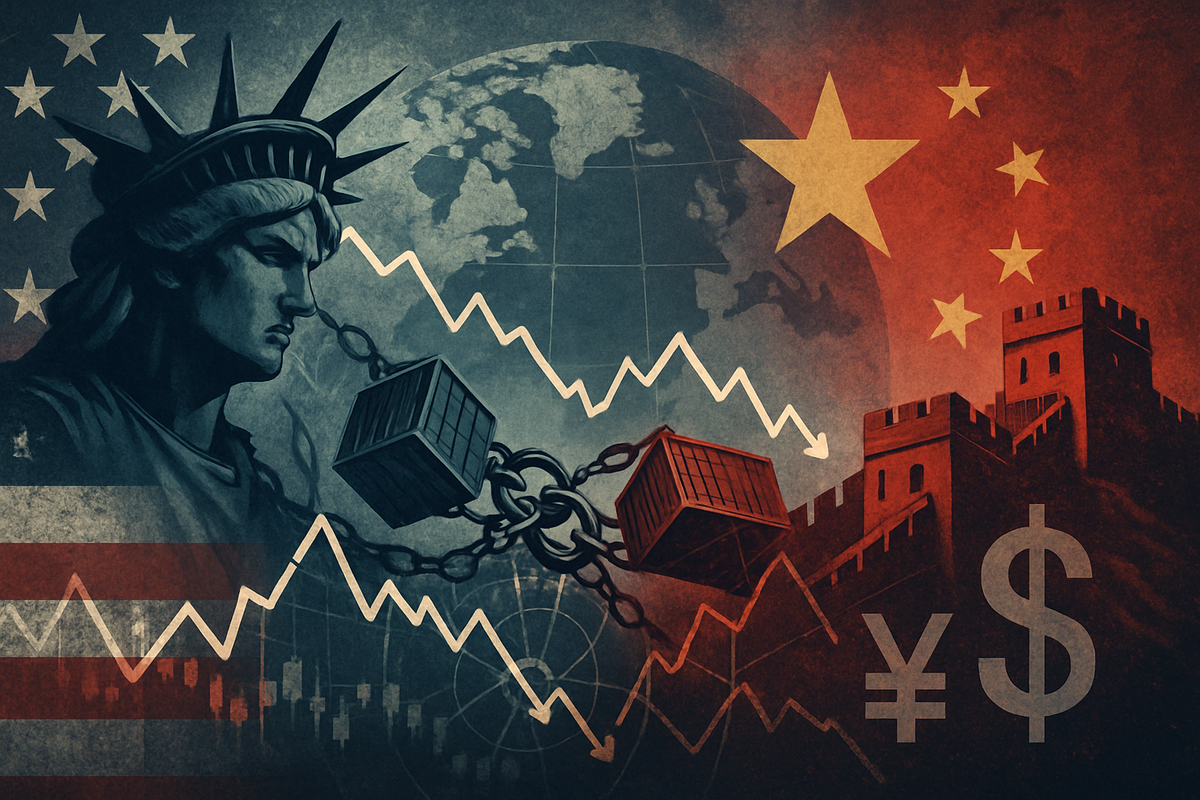
The economic relationship between the United States and China has entered a perilous new phase as of October 2025, marked by an intense escalation of trade tensions, aggressive tariff regimes, and a determined push towards economic decoupling. This renewed "trade war" under the second Trump administration is sending significant ripple effects across the global economy, directly impacting international trade flows, exacerbating supply chain vulnerabilities, fueling inflationary pressures, and injecting substantial instability into financial markets worldwide. The immediate implications point to a challenging landscape for businesses and consumers alike, as the world grapples with the unraveling of decades of economic integration.
The current climate of confrontation is not merely a continuation of past disputes but represents a deliberate strategic shift by both nations to reduce mutual dependence in critical sectors. With average US tariffs on Chinese goods soaring to approximately 57.6% and China's retaliatory tariffs on American goods reaching around 32.6%, the aggressive tariff environment has become a defining feature. While temporary "tariff truces" have offered brief reprieves, the underlying distrust and competitive pressure persist, leading many to characterize the situation as a "systemic economic divorce" with profound consequences for global commerce and geopolitical stability.
A Year of Escalation: Tariffs, Tech Wars, and Rare Earths
The year 2025 has witnessed a rapid and alarming escalation of trade tensions through a series of policy announcements and retaliatory measures, fundamentally reshaping the global economic landscape. President Trump's second term, commencing in January, swiftly prioritized a review of US trade relationships, particularly with China. This led to the imposition of a 10% tariff on most Chinese goods in February, which was quickly raised to 20% by early March.
April saw the implementation of "Liberation Day" tariffs, introducing a universal 10% tariff on imports from all countries not subject to other sanctions, effective April 5. The US further intensified pressure by increasing tariff rates on Chinese, Hong Kong, and Macau goods to 125%, resulting in a total effective tariff rate of 145% on US imports from these regions. In a swift and direct retaliation, China raised its additional tariff on US goods from 84% to 125% effective April 12. While May brought a temporary mutual reduction to a 30% tariff rate for Chinese and Hong Kong goods for a 90-day period, the respite was short-lived. June saw tariffs on steel and aluminum imports from all countries rise to 50%, alongside a 50% tariff on certain household appliances containing these metals. July added a 50% tariff on various semi-finished copper products. An executive order in August extended a tariff truce with China until November 10, 2025, temporarily averting a planned escalation that could have seen US duties on Chinese goods jump even higher.
However, the most significant escalations have occurred in September and October. In late September, the US Commerce Department expanded its "Entity List" to target companies using subsidiaries to circumvent export restrictions on chipmaking equipment and other high-tech goods. The US Senate also moved to prohibit US biotech firms from sourcing from designated Chinese companies. New US tariffs on softwood timber (10%) and certain furniture items (25%) were announced, effective October 14, with further increases planned for 2026. The situation intensified dramatically on October 9 when China significantly expanded its export controls on rare earth elements (REEs) and related technologies, effective December 1, citing national security. These controls now encompass refining technologies and products containing even trace amounts of Chinese-processed REEs. In a direct and forceful response, President Trump announced on October 10 an additional 100% tariff on Chinese imports, effective November 1, potentially pushing overall effective tariff rates to 130% or even 145% in some sectors. The US also introduced new export controls on "any and all critical software." Retaliatory actions from China followed, including an antitrust probe into Qualcomm (NASDAQ: QCOM) and increased port fees on US-linked vessels, effective October 14. US Treasury Secretary Scott Bessent has publicly criticized China as an "unreliable partner," while China's Commerce Ministry has vowed to "fight to the end." These rapidly escalating tensions are now threatening a planned Asia-Pacific Economic Cooperation (APEC) summit meeting between President Trump and Chinese Premier Xi Jinping on October 31.
Companies Navigating the Crosscurrents: Winners and Losers
The intensifying US-China trade tensions are creating a bifurcated market, with some companies facing significant headwinds and others potentially finding new opportunities amidst the disruption. The immediate impact is most acutely felt by companies heavily reliant on global supply chains and those operating in sectors targeted by tariffs or export controls.
On the losing side, multinational corporations with extensive manufacturing operations in China, particularly those exporting to the US, are facing severe pressure from increased tariffs. Consumer electronics giants like Apple (NASDAQ: AAPL) and HP (NYSE: HPQ), which have significant production bases in China, are grappling with higher input costs and potential demand shifts. The expanded rare earth export controls from China pose a critical threat to industries that rely on these essential minerals. US defense contractors, aerospace companies like Boeing (NYSE: BA), and semiconductor manufacturers such as Nvidia (NASDAQ: NVDA) and Intel (NASDAQ: INTC) are particularly vulnerable to disruptions in the supply of rare earth components, which are crucial for everything from F-35 avionics to advanced chip production. Agricultural companies, especially those exporting soybeans, corn, and other commodities to China, continue to face reduced demand and retaliatory tariffs, impacting their profitability. Furthermore, any company relying on Chinese-made steel, aluminum, or now, certain furniture items, will see increased import costs.
Conversely, some companies and sectors may emerge as relative winners. Domestic US manufacturers in industries protected by tariffs, such as steel producers like Nucor (NYSE: NUE) and Cleveland-Cliffs (NYSE: CLF), or aluminum producers, could see increased demand for their products as imports become more expensive. Companies that have successfully diversified their supply chains away from China to countries in Southeast Asia, Mexico, or even back to the US, stand to benefit from reduced tariff exposure and greater operational resilience. Technology companies focusing on domestic production or those offering alternatives to Chinese high-tech components could also see a boost. Additionally, logistics and shipping companies specializing in re-routing supply chains or those with operations outside the direct US-China trade routes might find new business opportunities. Companies providing automation and robotics solutions for reshoring manufacturing could also experience increased demand. However, even for potential "winners," the overall global economic slowdown and market volatility present significant risks.
Wider Significance: Decoupling, Geopolitics, and Historical Echoes
The escalating US-China trade tensions extend far beyond mere tariff disputes, signaling a fundamental shift in global economic architecture and geopolitical dynamics. This current phase represents an accelerated drive towards economic decoupling, challenging the decades-long paradigm of interconnected global supply chains and integrated markets. Both Washington and Beijing are actively pursuing strategies to reduce their economic interdependence in strategic sectors, forcing other nations to navigate an increasingly bifurcated global trade system, a development that the World Trade Organization (WTO) Director-General has warned is "profoundly worrying."
This event fits into broader industry trends emphasizing supply chain resilience and diversification. Companies are under increasing pressure to de-risk their operations from over-reliance on any single country, particularly China. This could lead to a significant reconfiguration of global manufacturing footprints, with potential ripple effects on competitors and partners across various industries. For instance, the rare earth export controls could incentivize significant investment in mining and processing capabilities outside China, impacting companies like Lynas Rare Earths (ASX: LYC) or MP Materials (NYSE: MP). Regulatory and policy implications are also profound, with governments worldwide considering new incentives for domestic production, export controls on critical technologies, and investment screening mechanisms to protect national security interests. The US prohibition on biotech firms sourcing from designated Chinese companies is a prime example of this trend.
Historically, major trade wars have often led to global economic slowdowns and, in some cases, contributed to broader conflicts. Comparisons are frequently drawn to the Smoot-Hawley Tariff Act of 1930, which exacerbated the Great Depression by triggering a wave of retaliatory tariffs and a collapse in global trade. While the current situation is different in its specifics, the underlying mechanism of escalating protectionism leading to reduced trade and economic contraction remains a potent historical precedent. The International Monetary Fund (IMF) has explicitly warned that a renewed US-China trade war could significantly reduce global GDP, echoing the lessons of history. The weaponization of trade, technology, and critical resources like rare earths signifies a new era of strategic competition, where economic tools are increasingly used to achieve geopolitical objectives.
What Comes Next: A Precarious Path Forward
The path ahead for the global economy amidst escalating US-China trade tensions is fraught with uncertainty, presenting both significant challenges and potential strategic pivots. In the short-term, the immediate focus will be on the expiration of the current tariff truce on November 10, 2025, and the implementation of the additional 100% US tariffs on Chinese imports effective November 1. The outcome of the planned APEC summit meeting between President Trump and Chinese Premier Xi Jinping on October 31 will be critical, potentially offering a momentary de-escalation or further entrenching the adversarial stance. Businesses must brace for continued supply chain disruptions, increased import costs, and persistent market volatility, necessitating agile risk management and contingency planning.
Long-term possibilities include a further acceleration of economic decoupling, leading to the formation of distinct economic blocs centered around the US and China. This could result in a more fragmented global trading system, with companies being forced to choose sides or operate within segmented markets. Strategic pivots will be essential for survival. Companies will need to invest heavily in supply chain diversification, exploring new sourcing locations, nearshoring, or even reshoring production where feasible. Innovation in materials science to reduce reliance on rare earths, or investment in alternative processing technologies, will become paramount for affected industries. Market opportunities may emerge for countries and companies that can offer viable alternatives to Chinese manufacturing or provide critical resources outside of China's control. Furthermore, sectors focused on domestic infrastructure development, advanced manufacturing, and strategic technologies in the US could see increased investment.
Potential scenarios range from a continued, gradual escalation of tensions, where tariffs and export controls become permanent features of the economic landscape, to a more severe "hot trade war" that could trigger a significant global recession. A less likely, but still possible, scenario involves a negotiated settlement that addresses some of the core grievances, though the current rhetoric suggests this is not imminent. Investors should prepare for continued market volatility, with particular attention to sectors heavily exposed to either Chinese demand or supply chains. The geopolitical implications will also continue to evolve, potentially reshaping alliances and international trade agreements.
Comprehensive Wrap-up: Navigating a Fractured Global Economy
The current escalation of US-China trade tensions represents a pivotal moment for the global economy, moving beyond traditional trade disputes into a realm of strategic economic warfare and deliberate decoupling. Key takeaways from this period include the significant rise in tariffs on both sides, China's weaponization of rare earth exports, and the US's expanded export controls on critical technologies. This "systemic economic divorce" is accelerating the fragmentation of global supply chains, pushing up inflation, and creating profound uncertainty in financial markets.
Moving forward, the market will remain highly sensitive to any policy announcements from Washington and Beijing, particularly regarding tariffs, export controls, and potential diplomatic engagements. Companies with robust, diversified supply chains and those operating in sectors shielded from direct trade conflict may prove more resilient. Investors should closely monitor commodity prices, particularly for rare earths and other critical minerals, as well as the performance of multinational corporations with significant exposure to both the US and Chinese markets. The agricultural sector and technology companies reliant on global component sourcing will continue to face considerable headwinds.
The lasting impact of these tensions could be a fundamentally reshaped global economic order, characterized by regionalized supply chains, increased protectionism, and a more pronounced geopolitical influence on trade and investment decisions. What investors should watch for in the coming months includes the outcomes of any high-level diplomatic meetings, further retaliatory measures from either side, the resilience of global supply chains, and the broader macroeconomic indicators such as inflation and GDP growth. The era of seamless globalization appears to be giving way to a more fractured and competitive economic landscape, demanding vigilance and adaptability from all market participants.
This content is intended for informational purposes only and is not financial advice






